Diversity and inclusion initiatives are healthy business imperatives.
According to a recent research report — Women in the healthcare industry — issued by McKinsey & Company, healthcare appears to be one of the best industries for working women on several dimensions. The consultancy looked at the broad industry, including drug and medical-device 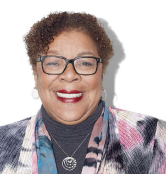 manufacturers, as well as service providers and payers, and found that healthcare surpasses other industries in female representation. Women are the primary consumers and decision makers in the healthcare market, and they make up almost 50% of the workforce; much of their advancement and leadership in the field rests on those facts.
manufacturers, as well as service providers and payers, and found that healthcare surpasses other industries in female representation. Women are the primary consumers and decision makers in the healthcare market, and they make up almost 50% of the workforce; much of their advancement and leadership in the field rests on those facts.
Women do hold executive management positions 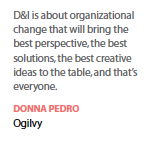 at the highest levels across the various sectors, including Dr. Deborah Dunsire, CEO of Lundbeck, Emma Walmsley, CEO of GlaxoSmithKline, Gail Boudreaux, president and CEO of Anthem, Laura Dietch, president and CEO of BioTrace.
at the highest levels across the various sectors, including Dr. Deborah Dunsire, CEO of Lundbeck, Emma Walmsley, CEO of GlaxoSmithKline, Gail Boudreaux, president and CEO of Anthem, Laura Dietch, president and CEO of BioTrace.
And there are dozens more examples of female CEOs in the biotech and med-device space, including Maria Fardis, Ph.D., president and CEO, Iovance Biotherapeutics, Rachel King, co-founder and CEO of GlycoMimetics, Helen Torley, Ph.D., president and CEO of Halozyme, Andrea Pfeifer, Ph.D., CEO of AC Immune, Paula Ragan, Ph.D., CEO of X4 Pharmaceuticals, and Dr. Lan Huang, co-founder, chairman and CEO of BeyondSpring. (Editor’s note: Tune into the PharmaVOICE WoW podcast series to learn about the career journeys of some of these leaders.)
There are also numerous women who operate at the highest levels in the healthcare services industry, including Sharon Callahan, CEO at 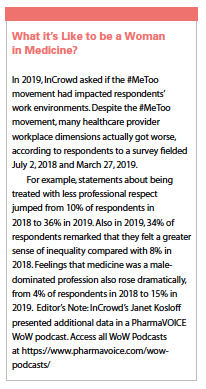 TBWA\WorldHealth, Jennifer Gottlieb, president of W2O, and Julie Ross, president of Advanced Clinical.
TBWA\WorldHealth, Jennifer Gottlieb, president of W2O, and Julie Ross, president of Advanced Clinical.
That said, according to McKinsey, women, especially women of color, remain underrepresented in leadership positions, and not only at the highest levels.
Even as companies work toward greater gender and diversity balance, challenges remain to address hiring, advancement, and day-to-day experiences that could promote a more flexible and inclusive working culture.
Good, But Still a Ways to Go
McKinsey reports that more than 60% of employees entering the healthcare industry are women, while across sectors in the United States, women represent an average of just under 50% of entry-level employees.
Studies show that gender diversity and inclusion (D&I) is especially important for companies in the pharma, biotech, and device subsectors especially since women make 50% of all healthcare decisions for themselves and their families.
“It is critically important for all companies to have a D&I strategy," says Laurie Cooke, CEO and president of the Healthcare Businesswomen’s Association. “The business case for diversity of thinking is so well-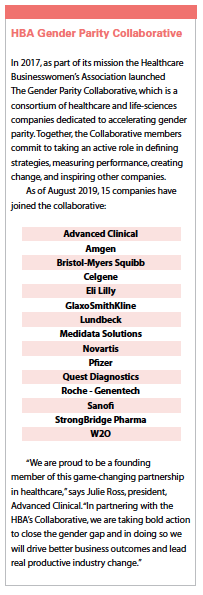 documented that if a company wants to optimize its access to the best and brightest talent, if it wants to achieve increased engagement, retention, and innovation, and if it wants to maximize financial returns, it should have a plan to attract, retain, and optimize the people they have around the table. Diversity is being asked to the party, inclusion is being asked to dance, and belonging is enjoying yourself while you’re there. This is why companies need a strategy as to how to get the best talent to the table, sharing their ideas, and fully engaging with colleagues so they stick around."
documented that if a company wants to optimize its access to the best and brightest talent, if it wants to achieve increased engagement, retention, and innovation, and if it wants to maximize financial returns, it should have a plan to attract, retain, and optimize the people they have around the table. Diversity is being asked to the party, inclusion is being asked to dance, and belonging is enjoying yourself while you’re there. This is why companies need a strategy as to how to get the best talent to the table, sharing their ideas, and fully engaging with colleagues so they stick around."
The good news, when comparing the rate of promotions between men and women across industries, the healthcare industry performs better than average. Also, McKinsey reports that on average, women in healthcare report high satisfaction with their careers — 75% vs. 71% of men. They find opportunities aligned with their passions and can adapt their careers over time.
While there is a lot to celebrate and most employers see diversity as a priority, examining the representation of women across different levels indicate that healthcare still faces challenges in sustaining a diverse workforce. For example, as in other sectors, the proportion of women in the healthcare industry decreases as the responsibility level of the job rises. The share of white women in entry-level positions is 41% compared with 26% at the C-suite level. This decline is particularly steep for white women at more senior levels, such as VP, senior VP, and C-suite, due to the glass ceiling that seems to exist between senior manager/director and VP levels. Also, according to McKinsey, the share of women of color drops off even more, with 22% holding entry-level jobs and just 4% working at the C-suite level. Declines in representation for women of color span all levels of employment. The glass ceiling for women of color starts at the first promotion to manager.
McKinsey finds there are three emerging problems that lead to representation decline in healthcare: structural challenges, such as hiring and advancement practices; institutional barriers allowing underlying biases to persist; and impact of the daily work environment not promoting an inclusive and supportive experience for all employees. Companies need to better understand and address these key challenges if they are committed to promoting diversity.
While the study did not find specific reasons to explain why women of color lag further behind, McKinsey’s research suggests all of the factors that apply to women generally — such as unequal promotions and microaggressions — are amplified for women of color, and are likely contributing factors in the healthcare industry as well.
Moving Forward
“Typically organizations have been built and still reward leaders on an outdated models based on a white male with a wife at home as the norm," Ms. Cooke says. “In light of continuing studies that demonstrate that more feminine leadership traits get the highest marks, and the workforce no longer looks like this demographic so organizations would greatly benefit from examining what they define as the target behaviors, competencies, and deliverables of a successful leader and test whether these things really are must haves, measure if women and men of all diversity groups are equally stepping forward and advancing, and then retooling what isn’t working as intended."
The key to accelerating and having a greater impact at scale is two-fold, according to McKinsey. First, companies need to focus on the shifts that matter to their organization.For this, they need real data as a starting point. Second, companies need to reframe their efforts against core actions that are shown to have an impact.
Of these six core actions, analysts suggest focusing on three in particular to address challenges faced by women in the healthcare industry: promotions and external hiring, inclusiveness training, and flexibility in the workplace.
To address the problem of promotion bottlenecks, one thing companies can do that has been found to be effective is to identify and groom women within the organization to compete for senior positions; this form of sponsorship can be developed through training. But analysts say this, in and of itself, is not sufficient. Unconscious bias can have a significant impact on who’s hired and promoted — and who’s not. McKinsey recommends that companies put safeguards in place to reduce bias such as using automated résumé-screening tools, requiring diverse slates of candidates, and setting clear, consistent evaluation criteria before the process begins.
Furthermore, analysts say it’s important to track outcomes. Otherwise, it’s impossible for a company to know if it’s treating candidates fairly. Many companies track outcomes in hiring to check for gender bias, which is a good start experts say. But far fewer companies track the compounding effect of gender and racial bias, which disadvantages women of color. And companies are far less likely to track bias in performance reviews, for example, to see if women’s communication styles are criticized more often 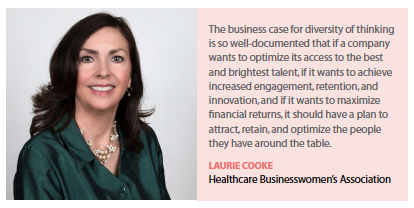 than men’s. This in and of itself can lead to gender gaps within an organization as performance reviews play a significant role in who gets promoted and who doesn’t.
than men’s. This in and of itself can lead to gender gaps within an organization as performance reviews play a significant role in who gets promoted and who doesn’t.
HBA’s Ms. Cooke provides three simple pieces of advice that are crucial for companies to create metrics for themselves. “First, it’s essential to establish benchmarks for the company against relevant industry counterparts; a company can’t know if it is making progress if it doesn’t know where it started from. Second, prioritize a handful of the most important areas that would make the biggest difference; if you try to boil the ocean, you’re likely to make very little progress and even be discouraged. Third, agree to the targets and connect achievement of the targets to leaders’ compensation."
McKinsey also recommends that companies invest in training to create a more diverse and inclusive employee culture. D&I training can help improve hiring, sponsorship, employee development, and raise awareness of the business case for D&I. Employees understand and support the value of D&I. However, managers don’t regularly address learning moments or role model key behaviors and mind-sets.
Donna Pedro, chief diversity and inclusion officer, worldwide, at Ogilvy, who has been at the forefront of D&I for almost 30 years, believes initiatives need to expand beyond looking strictly at race and gender. “This view puts D&I in a very, very small box," she says. “I think we have to look at everything that everyone brings to the table — sexual orientation, identity, religion, ethnicity, etc. D&I is about organizational change that will bring the best perspectives, the best solutions, and the best creative ideas to the table, and that’s everyone."
By leveraging both formal and informal training opportunities, managers can help employees feel more confident in what to do and when. Training needs to do the following:
provide unconscious-bias training and reminders for hiring managers as they select interview slates and make offer decisions;
foster sponsorship and mentoring;
recognize senior leaders who are spearheading D&I initiatives in their organizations and educate line managers on how to promote D&I within their teams;
provide professional development training to accelerate the career trajectories of high-potential women and underrepresented minorities;
make managers aware of the signs and impact of microaggressions;
give employees the flexibility to fit work into their lives.
“Companies have to make a commitment to disrupt the bias, and this starts with leadership," she says. “When I say disrupt the bias, I mean in every 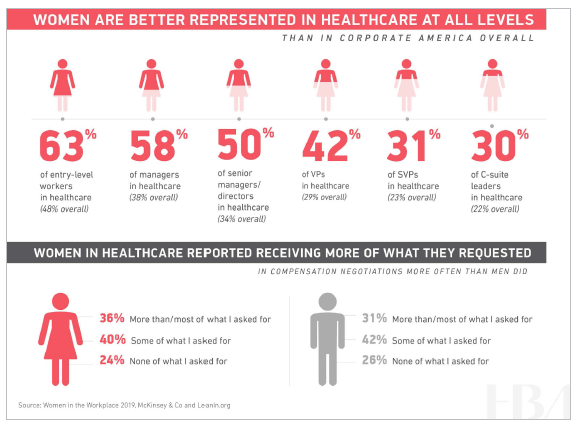 aspect of the employee lifecycle. Companies need to recognize where bias can creep into the process starting at recruitment to selection, to promotion, to assignment, to who is running meetings, etc. It’s crucial to get leaders to commit and then follow up. If the commitment was to have more women in leadership, what was done? Are meetings being run differently? Training is a foundational piece, but it’s not enough. There has to be leadership support and accountability, this is critical."
aspect of the employee lifecycle. Companies need to recognize where bias can creep into the process starting at recruitment to selection, to promotion, to assignment, to who is running meetings, etc. It’s crucial to get leaders to commit and then follow up. If the commitment was to have more women in leadership, what was done? Are meetings being run differently? Training is a foundational piece, but it’s not enough. There has to be leadership support and accountability, this is critical."
Some of the most effective tools Ms. Pedro has used are dashboards that allow senior leaders involved with talent acquisition to see at any point in time what their professional pipeline looks like in terms of leaders, directors, managers, etc. “The first thing an organization should do is take an honest look at what it looks like at all different levels and then make sure it has the right culture in place to achieve its goals," she says.(PV)
~~~~~~~~~~~~~~~~~~~~~~~~~
What it’s Like to be a Woman in Medicine?
In 2019, InCrowd asked if the #MeToo movement had impacted respondents’ work environments. Despite the #MeToo movement, many healthcare provider workplace dimensions actually got worse, according to respondents to a survey fielded July 2, 2018 and March 27, 2019.
For example, statements about being treated with less professional respect jumped from 10% of respondents in 2018 to 36% in 2019. Also in 2019, 34% of respondents remarked that they felt a greater sense of inequality compared with 8% in 2018. Feelings that medicine was a male-dominated profession also rose dramatically, from 4% of respondents in 2018 to 15% in 2019. Editor’s Note: InCrowd’s Janet Kosloff presented additional data in a PharmaVOICE WoW podcast. Access all WoW Podcasts at https://www.pharmavoice.com/wow-podcasts/
~~~~~~~~~~~~~~~~~~~~~~~~~
HBA Gender Parity Collaborative
In 2017, as part of its mission the Healthcare Businesswomen’s Association launched The Gender Parity Collaborative, which is a consortium of healthcare and life-sciences companies dedicated to accelerating gender parity. Together, the Collaborative members commit to taking an active role in defining strategies, measuring performance, creating change, and inspiring other companies.
As of August 2019, 15 companies have joined the collaborative:
Advanced Clinical
Amgen
Bristol-Myers Squibb
Celgene
Eli Lilly
GlaxoSmithKline
Lundbeck
Medidata Solutions
Novartis
Pfizer
Quest Diagnostics
Roche – Genentech
Sanofi
StrongBridge Pharma
W2O
“We are proud to be a founding member of this game-changing partnership in healthcare," says Julie Ross, president, Advanced Clinical. “In partnering with the HBA’s Collaborative, we are taking bold action to close the gender gap and in doing so we will drive better business outcomes and lead real productive industry change."


















